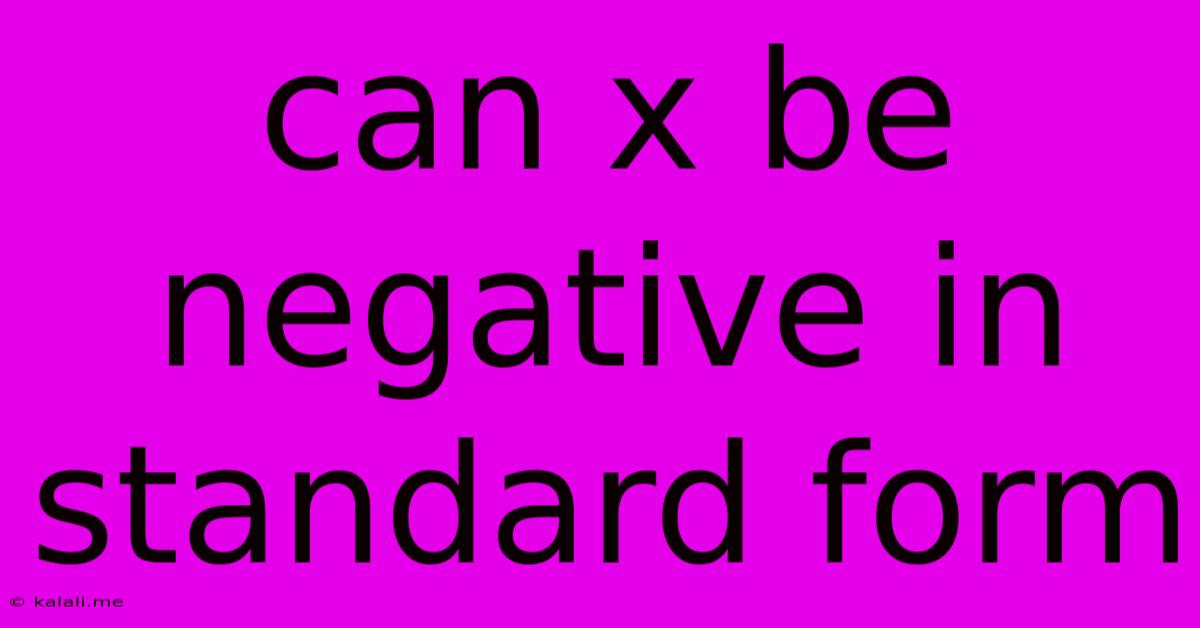Can X Be Negative In Standard Form
Kalali
Jun 09, 2025 · 3 min read

Table of Contents
Can x be Negative in Standard Form? A Deep Dive into Quadratic Equations
The question, "Can x be negative in standard form?" is a common one among students grappling with quadratic equations. The answer isn't a simple yes or no, but rather depends on the specific equation and what "standard form" refers to in this context. This article will clarify this point, exploring the nature of quadratic equations and the solutions they can yield.
Understanding Standard Form of a Quadratic Equation
The standard form of a quadratic equation is typically written as:
ax² + bx + c = 0
where 'a', 'b', and 'c' are constants, and 'a' is not equal to zero. 'x' represents the variable we are trying to solve for. The solutions to this equation, often called roots or zeros, represent the x-intercepts of the parabola represented by the equation when graphed.
Can the Solutions (x-values) be Negative?
The crucial point is that the solutions for 'x' can absolutely be negative. The standard form itself doesn't restrict the solutions to positive values. The values of 'a', 'b', and 'c' determine the nature and value of the roots.
Let's explore different scenarios:
Scenarios with Negative Solutions
-
Example 1: Consider the equation x² + 3x + 2 = 0. Factoring this gives (x + 1)(x + 2) = 0. Therefore, the solutions are x = -1 and x = -2. Both solutions are negative.
-
Example 2: The quadratic formula,
x = (-b ± √(b² - 4ac)) / 2a, is a powerful tool for solving quadratic equations. Depending on the values of a, b, and c, the discriminant (b² - 4ac) can result in negative solutions for x. For example, if a=1, b=2, c=3, the discriminant is negative, leading to complex roots. The real part of the solution may or may not be negative, which would be the x-coordinate if this were plotted on the complex plane. -
Example 3: A parabola can intersect the x-axis at negative x-values. This intersection point represents a negative solution for x.
Scenarios with Positive or Mixed Solutions
The solutions can also be positive, zero, or a combination of positive and negative numbers. This depends entirely on the coefficients (a, b, and c).
It's also important to understand that:
-
Complex Roots: If the discriminant (b² - 4ac) is negative, the solutions will be complex numbers (involving the imaginary unit 'i'). While they may have a negative real component, they are not simply negative real numbers.
-
Repeated Roots: It's possible for a quadratic equation to have a repeated root (the same value for x). This root could be positive, negative, or zero.
In Conclusion:
The standard form of a quadratic equation does not prohibit negative solutions for 'x'. The solutions are determined by the values of the coefficients (a, b, and c) and can be positive, negative, zero, or complex numbers. Understanding the quadratic formula and different methods of solving quadratic equations is key to determining the nature of these solutions. Therefore, the answer to "Can x be negative in standard form?" is a resounding yes.
Latest Posts
Latest Posts
-
What Is Half Of 1 4 Teaspoon
Jul 02, 2025
-
How Many Cups In A Pound Of Hamburger Meat
Jul 02, 2025
-
Imagery Or Figurative Language From Romeo And Juliet
Jul 02, 2025
-
What Is A Quarter Of A Million
Jul 02, 2025
-
Which Of The Following Is True Concerning A Dao
Jul 02, 2025
Related Post
Thank you for visiting our website which covers about Can X Be Negative In Standard Form . We hope the information provided has been useful to you. Feel free to contact us if you have any questions or need further assistance. See you next time and don't miss to bookmark.